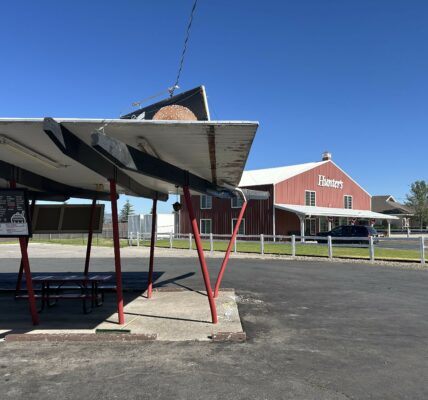By Mike Koshmrl
Jackson Hole Daily
Via- Wyoming News Exchange

JACKSON — The Wyoming Game and Fish Department will eliminate the legally embattled Alkali Creek elk feedground in coming years as the threat of chronic wasting disease looms.
The Bridger-Teton National Forest feedground, the lowest elevation of three in the Gros Ventre River valley, had been studied and then authorized for long-term use in 2015. But four environmental groups hit the forest with a lawsuit, winning in 2018.
Rather than appealing or spending years studying the feedground’s impacts to address the judge’s concerns, the Forest Service and Wyoming wildlife managers came up with a plan that will allow emergency elk feeding at Alkali for five years and then end the operation by 2024. That plan is now being “scoped” and is open for public comment.
“Game and Fish met with individuals from the Jackson Ranger District and supervisor’s office to discuss this proposal,” District Ranger Mary Moore said. “They drafted a formal proposal in writing to us regarding the next steps at Alkali Creek feedground, and we are formally assessing the impacts of that before we make a decision to permit that activity.”
The terms allow elk feeding on only 5 acres of the 91 acres historically used for the operation, and only in the event of an “emergency.” Qualifying conditions include if elk are damaging nearby private lands or mixing with cattle, if feeding is necessary to stop a “large down drainage movement” of animals toward the National Elk Refuge, or if there are 300 elk staged at Alkali and they are not dispersing. A Bridger-Teton employee must concur with the state’s declaration of need for emergency feeding.
At the end of five years, “if necessary,” the Bridger-Teton could grant another five-year extension of the emergency feeding permit, which would continue the historic, controversial means of managing elk until as late as 2029.
As a practice, elk feeding is used to help sustain herds through tough winters, keep wapiti off private haystacks and feed lines, and generally prop up populations.
On the flip side, it’s considered anachronistic to feed elk, and doing it routinely was mostly abandoned by other Western states decades ago.
The National Elk Refuge and Wyoming’s 22 feedgrounds, which collectively nourish over 20,000 elk annually, amounts by far to the largest strategic feeding operation remaining in North America. Wildlife management has evolved away from feeding partly because it promotes the abandonment of migration routes, distorts natural distribution and spreads diseases by keeping animals closely quartered.
Brad Hovinga, who supervises Game and Fish’s regional office, said that there was a discussion about relocating the Alkali feedground to private land, but the idea fizzled. He anticipates doing without a third feedground in the Gros Ventre, relying instead on the Patrol Cabin and Fish Creek feedgrounds higher up the drainage.
“It’s likely that the elk that would typically winter at Alkali would instead winter at Patrol Cabin or the National Elk Refuge,” Hovinga said. “So this changes little overall.”
Strategically, he said, the Alkali feedground’s importance has waned anyway.
“We don’t have the conflicts with local private properties that we had years ago, and we’ve fed significantly less elk there than we did in the past,” Hovinga said.
At times in recent years, Alkali hasn’t been used at all, as the elk in the valley east of Jackson have bunched up as a single herd, spending most of their time at the Patrol Cabin feedground.
Although litigation is what put the Bridger-Teton and Game and Fish on the path to phasing out the feedground, the terms of the phase-out plans are coming straight from the state.
“We just wanted to make sure that we could go through a phase-out successfully,” Hovinga said, “without having major damage in the drainage.”
Partly, it was deference to the state that caused U.S. District Court Judge Nancy Freudenthal to throw out the Bridger-Teton’s 2015 reauthorization of the Alkali feedground. She also faulted federal managers for failing to take a “hard look” at alternatives to feeding elk.
“Important to the issues raised in this case, the Service eliminated an alternative to improve winter range on the [Bridger-Teton] and eliminate all elk feeding in an effort to restore historical migration routes,” Freudenthal ruled. “There is no question that Alkali Creek Feedground could become a reservoir for [chronic wasting disease] infection if it becomes established in elk populations in Northwest Wyoming. That potential is increased with the concentration of elk at feedgrounds.”
Game and Fish officials have said that they plan to explore changes to the 21 other elk feedgrounds by creating a working group, but the agency’s director, Brian Nesvik, has told the News&Guide that feeding in the face of the disease is the “best decision” at this time.
Although it has been found locally only in mule deer so far, chronic wasting disease, which is incurable and always lethal, has spread into the feedground region in recent years, reaching Grand Teton National Park last fall and being confirmed in the Wyoming Range this fall.
The four environmental groups whose lawsuit led to the planned gradual closure of the Alkali feedground are The Sierra Club, Western Watersheds Project, Wyoming Wildlife Advocates and the Gallatin Wildlife Association.
The Bridger-Teton is accepting public comments on the Alkali feedground phase-out plan through Oct. 18.






